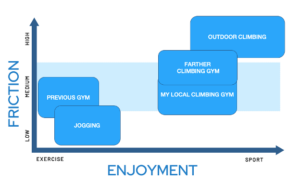1. Acknowledge the Process is Hard
Most of us, at one point or another, have had to name something. Perhaps a child, pet, or houseplant? (It helps me to remember to water them.) Maybe you even had a list of cool band names just in case you needed it one day… after you got around to learning an instrument. For most of us, that process is deeply personal, time-consuming, and mostly a lot of fumbling around until you hit upon something that just feels right. But if you’re naming things in a professional context, going purely by feel won’t do. Stakeholders will want to understand how you came to your recommendation.
If you work in an organization and have a budget, you’ll benefit from hiring a firm like Taoti. We can help you tailor the process to your stakeholders and business needs, including recommending and managing first-party research where appropriate. But we understand that not everyone can afford to hire help. So, we offer this advice to those doing this on their own.
2. Define Your Audience as a Single Person
“But I have to sell to more than one person!” I can hear you protest. And yes, of course, you do. That’s true for every business. But for each product or service, there’s a prototypical ideal person for which your company’s solution was designed. If you do an excellent job crafting your brand for that perfect person, other people will identify with their situation and consider themselves to be your audience. So, for now, let’s focus on one hypothetical perfect person that I like to call the Muse.

Image courtesy of Being John Malkovitch, (c) 1999 USA Films/Universal pictures
Describe this ideal person as if you’re writing a story and they’re a character. If you just started with something like, “okay… they’re between the ages of 30 and 55…” please stop. Yes, this is how we’ve all been taught to think of our target audience: as a range defined by its edges. But this is not at all how we define individuals in our minds. Instead, use precise and descriptive adjectives. Demographics have age ranges; people have ages.
As an example, here is the Muse for a climbing gym opening on H Street NE in DC, a neighborhood with an interesting mix of 1 and 2-bedroom luxury condos plus 100-year-old 2-4-bedroom row houses.
Here goes:
“William has decided he needs to get back in shape. At 54-years-old, this isn’t the first time he has come to this conclusion, but the other programs (membership to Gold’s Gym, daily running routine, keto) haven’t produced the progress he was hoping for. But then, the kids were younger and his job was more stressful. This new rock gym is very close to home and full of people interested in functional fitness rather than bodybuilding, like the guys at Gold’s who hogged all the weights.
3. Figure Out Who Your Competition Is
William has plenty of options for how he can get back into shape, just like your Muse will have alternatives to your business. Think through the options he will likely consider. Then try to identify how William feels about each one.
Here’s how you should document the Pros of your competition:
- Gold’s Gym (or any former gym)
- Used to belong, easy to get back into the habit.
- Exercises and classes are easy to understand, no learning curve.
- Reasonably priced
- Daily Running Routine
- Free (no membership)
- Have running shoes (no new equipment needed)
- Right outside the door (no travel time)
- Outdoor Climbing
- In nature
- No dues (though equipment is expensive)
- More social (requires a partner)
- Another Climbing Gym that’s across town
- Slightly larger
- Been open longer: more customers and reviews online (social proof)
- Plenty of parking
4. Define How You’re Different and Better
It’s obvious, right? I mean, who doesn’t know you are clearly a superior alternative to these options? Well, William doesn’t…yet. Let’s examine those same competitors again, this time from the perspective of “How is my business better?”
- Gold’s Gym (or previous gym)
- Functional fitness instead of bodybuilding (no meat heads)
- Sports activities are more fun than lifting weights
- Closer to home
- Daily Running Routine
- Climbing is more fun than running
- Indoor climbing can be done in all weather conditions comfortably
- You can always add some running to your routine
- Outdoor Climbing
- Indoor climbing can be done in all weather conditions comfortably
- Equipment is expensive
- Gym is closer to home than outdoor climbing sites
- Requires a partner to spot or belay
- Another Climbing Gym that’s across town:
- Closer to home
- Newer facility and equipmentNow that you’ve described your competitive space and how you stack up, you can determine what’s known at your Positioning, meaning how your business fits into your target audience’s mental map of your marketplace.
5. Create a Positioning Statement
What are our characteristics from the list above? I would suggest convenience (made up of location and ease of habit forming), cost, and enjoyment. Or perhaps we can even group “cost” in with “convenience” (as time and money are often the same thing) and call it “friction.” These are extremely common differentiating characteristics for local businesses, so not a big surprise, but no less powerful.
So, what is our mental “position” compared to the competition based on the two characteristics of “friction” and “enjoyment?”

As you can see here, our new climbing gym is more enjoyable than going back to the old gym or starting a jogging routine, and it has lower “friction” than the other climbing gym or climbing outside. So, our positioning becomes about being the most fun option nearby, which we can formalize in a positioning statement, such as:
“Our new climbing gym is the most fun way to get a workout close to home.”
Is that the perfect positioning statement? I honestly don’t know. Based on our conversations with this (fictional) client, it must be close. Does it tell us who (locals), what (gym), and why (fun)? Does this capture what they think their clients care most about? If not, we revise until we get there.
6. Think In Metaphors
Thinking and speaking in metaphors is practical shorthand for communicating complex ideas. We all have these concepts in our minds, so it only makes sense to leverage them in communication. We start with our positioning statement, which, in our example, is, “Our new climbing gym is the most fun way to get a workout close to home.” What are the common human experiences that involve fun close to home? Here are some examples:
- The local pub
- The park down the street
- A friendly neighbor’s home or shop keep’s business
Perhaps these examples include “fun,” and “close to home,” but wouldn’t imply “climbing gym” or “exercise.” What might?
A jungle gym? (fun, for kids at least, usually nearby, and good exercise)
The local playground? (a related idea, but perhaps more inclusive)
- A tree house? (involves fun, climbing, and evokes childhood memories of playing in the neighborhood)
- A local mountain or hiking trail? (Is there something that’s well-known enough in your neighborhood?)
- And we shouldn’t ignore the obvious option: actual rock climbing. Clearly, that’s a concept that could be helpful in communicating the benefits of our business.
I suggest challenging yourself to come up with at least ten metaphors before moving on to the next steps.
7. Harvest, Filter, then Select…or Repeat?
Then, it’s harvest time. Plug your metaphors into your favorite search engine and see what comes out. Start collecting words to add to your list of terms. Soon, you’ll end up with something that looks like this:

Then reorder the words so that they are no longer visibly associated with their metaphor, making it easier to evaluate each word’s meaning independently, such as this:

Then run through that list and eliminate those words that are overly generic (like tag), completely unknown to you (even after you just read about them, like Wantage), or have alternate, incorrect meanings (like watch). Don’t delete anything, as it’s not uncommon to change your mind about how you feel about a word, especially after you’ve gone through the process of building consensus with your team.
After you’ve run through your list, it should look something like this:

Notice that I’ve also bolded words that jumped out at me as especially positive, accurate, or otherwise meaningful relative to the positioning statement. Then I’ll filter out those eliminated (again: no deleting), to get something like this:

So, what do we have here? Is this a list of name options? Perhaps, but they also aren’t fully fleshed out, are they? You might find that many of the terms you’ve gathered and continue to like don’t feel like they can stand on their own. If that’s the case, it’s likely that you’ll want to deploy various modifiers to help with clarity and emphasis of communication. These modifiers could become a part of the name, such as “Igneous Rock Gym,” or “Indoor Mountaineer.” Or they could form a descriptive tagline, such as “Bedrock: Indoor climbing on H Street.” As you continue to assess and remove options (using the knowledge you’ve gained of your own target customer), try to focus on the core meaning of the word to determine if it helps convey the critical elements of your identity in the positioning statement. You might love the word because it’s fun or catchy, but if it doesn’t do the work of communicating how you’re special, drop it. Conversely, if the meaning is perfect but incomplete, or the sound or spelling isn’t ideal, keep it and iterate.
It is possible that you finish this exercise and you’re left with…nothing. What do you do then? Repeat! In my experience, less than half of the naming projects I’ve worked on found a result in one round of metaphors, but I’ve never needed more than three rounds before finding something decision-makers loved.
So, hang in there…your great new name is there to be discovered.
8. Do the Boring Part
Before you fall in love with your new name and start sharing it with friends and partners, do some basic due diligence: check with the US Patent & Trademark Office to see if anyone owns the trademark in your category. Research if there are any businesses in your area using the name, even if they’re not well-known or outside your category. And make sure there’s some version of the name available as a URL for your website. These issues should be resolvable, but you certainly don’t want to be blindsided once you’ve made a commitment.
9. Are We Done Yet?
So, what did we decide to name our fictional rock-climbing gym in DC? We didn’t. Yes, that’s a bit anticlimactic, I recognize. But choosing a name is a bit like putting on a hat: no one can do it for someone else and have it feel right. Selecting a name requires a gut level understanding of your target audience, your Muse. It requires truly understanding how what you’re doing is special and different from the competition, your positioning. We at Taoti can execute all these processes for you, accelerating results and increasing confidence that you’re making the decisions based on the right information. But in the end, you are the final decision-maker. The name must feel right. So, give yourself time and listen to your instincts. You won’t necessarily know the instant you’ve arrived, but with a little time and patience, one day soon you’ll know that you’ve found your perfect name.
